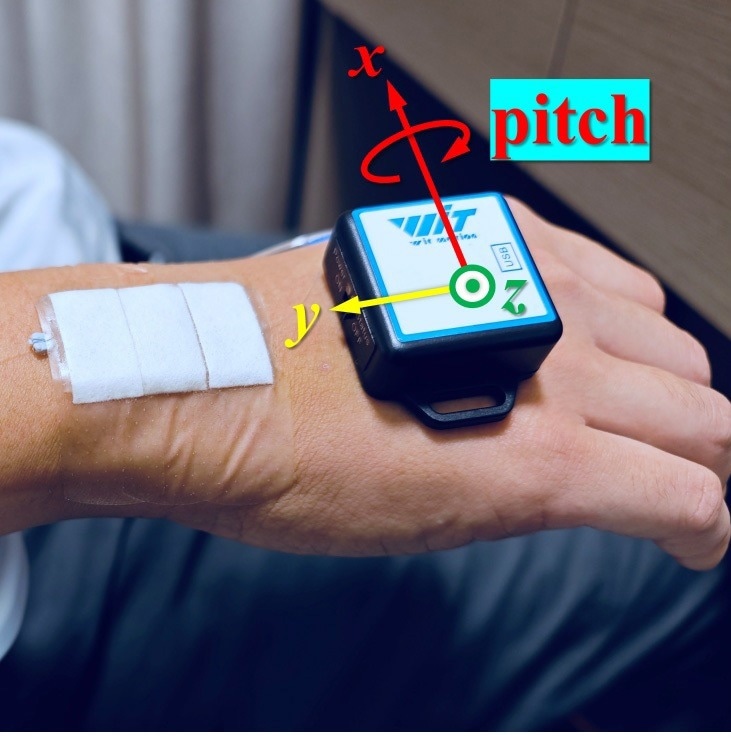Imagine wearing a thin, flexible sticker that can turn even the smallest of hand or finger movements into a form of communication without having to say a single word or tap a touch screen. A group of researchers in China has made that dream a reality by creating a new type of wearable sensor that can accomplish this futuristic feat, opening up new possibilities for rehabilitation applications and helping those with disabilities to communicate more easily.

Tests of the PDMS-embedded wearable FBG sensors demonstrated their capability to detect nuanced movements. Image Credit: Kun Xiao, Beijing Normal University in China
The novel sensor combines an optical element called a Fiber Bragg Grating (FBG) with a pliable and soft substance called polydimethylsiloxane, or PDMS. The researchers focused on making the devise comfortable to wear in the long term while also having the ability to detect movements with high accuracy.
For someone recovering from a stroke, these sensors could monitor wrist, finger, or even facial movements to monitor their rehabilitation progression, and for individuals with severe mobility or speech impairments, the sensors could translate gestures or facial expressions into words or commands, enabling them to communicate with others or interact with technology more easily.
Kun Xiao, Beijing Normal University
A multidisciplinary group of optical, biomedical, software, and electrical engineering experts from Beijing Normal University, Sun Yat-sen University, and Guilin University of Electronic Technology in China described the new sensor in the Optica Publishing Group journal Biomedical Optics Express.
Through experiments involving communication aids and gesture recognition, the sensors demonstrated a high degree of sensitivity and accuracy.
Beyond detecting movement, these adaptable sensors could be tailored for applications such as monitoring other health indicators like respiratory or heart rate by detecting subtle body movements, and they could also be useful for athletes or fitness enthusiasts to monitor and improve their form or technique in real time or be integrated into gaming systems for more immersive and interactive experiences.
Rui Min, Beijing Normal University
A Personalized Approach
This new study was motivated by the difficulties faced by individuals with disabilities and those recuperating from disorders like strokes, who frequently struggle with basic movements and communication. It is part of a bigger initiative that aims to produce revolutionary assistive technology.
Traditional methods are either too cumbersome, lacked accuracy, or were not versatile enough to cater to individual needs, and our goal was to develop a wearable solution that was both precise in detecting gestures and comfortable for everyday use, offering a more personalized and adaptive approach to rehabilitation and assistance.
Zhuo Wang, Beijing Normal University
The researchers used PDMS, a kind of skin-friendly and incredibly flexible silicone elastomer, to make patches to do this. People can use them without irritation or pain for extended periods of time.
The researchers placed FBGs, a form of reflector that is etched into a brief section of optical fiber to reflect select wavelengths while transmitting all others within the PDMS to give the patch its movement-sensing function.
The sensor makes it possible to detect slight changes in the way light propagates through the fiber optic during movement, allowing the system to detect specific movements by analyzing the alterations in light behavior.
Chuanxin Teng said, “The real magic comes from the combination of the PDMS with FBGs, and we found that using a thicker PDMS patch caused a more pronounced wavelength shift. Leveraging this sensitivity-enhancing effect of PDMS allows these optical sensors to detect even the slightest bend of a finger or twist of a wrist.”
The sensors have a wide range of uses and can be used on different parts of the body. Additionally, the researchers created a rigorous calibration technique that enables the sensors to be customized for every user and be used in a variety of applications.
Transforming Movement into Communication
To showcase the potential of their wearable FBG sensors with integrated PDMS, the researchers ran a number of tests with an emphasis on communication support and gesture identification. They affixed the sensors to various parts of the body, like the wrist and fingers, to detect distinct movements after individually calibrating the sensors for each participant.
They also created a system that enabled the sensors to translate simple gestures into commands or messages. For example, they used finger movements to spell out words based on Morse code.
The sensors showed excellent sensitivity and accuracy in identifying a variety of gestures in both tests. They could pick up on minute movements that some more conventional sensors would find challenging. The sensors successfully translated motions into words in the communication aid trial, demonstrating their potential as a helpful tool for those with speech or movement problems.
To prepare the technology for practical application and for future study through clinical trials, the researchers are currently striving to further enhance and improve it. This entails improving the sensors’ wireless communication capabilities with computers, smartphones, and medical equipment in addition to shrinking and integrating the sensor system even further to make it wearable.
This will provide real-time data monitoring and progress monitoring for caregivers and medical professionals by enabling people to engage with the system. To ensure that the sensors can resist normal wear and tear, including exposure to heat, moisture, and stretching, they are also enhancing the robustness and durability of the sensors.
Journal Reference:
Xiao, K., et al. (2024) PDMS-embedded wearable FBG sensors for gesture recognition and communication assistance. Biomedical Optics Express. doi.org/10.1364/boe.517104